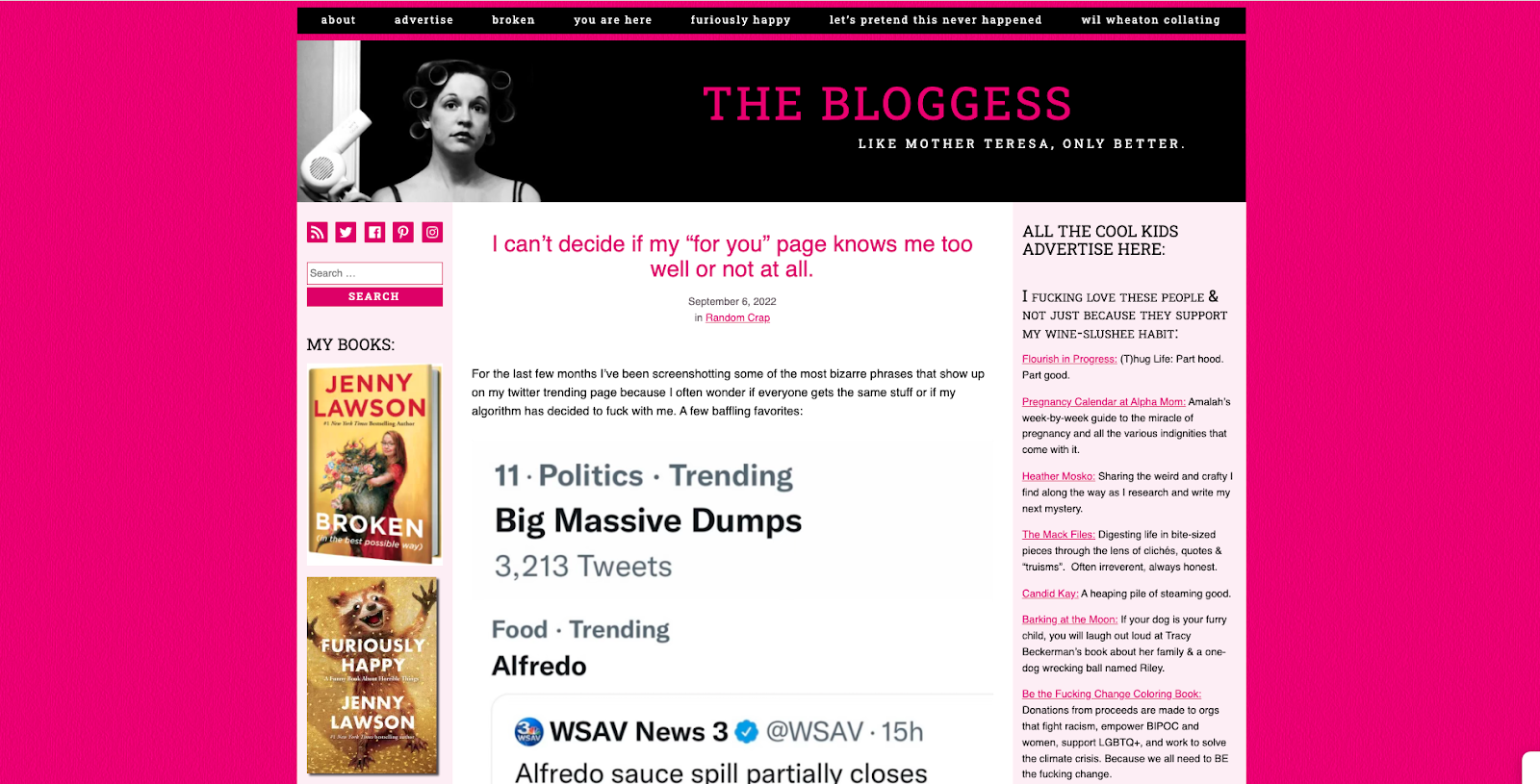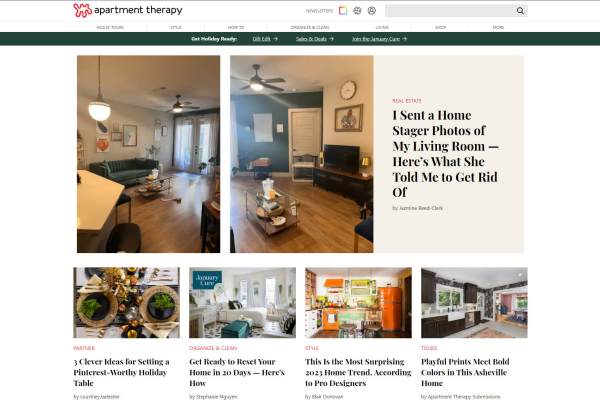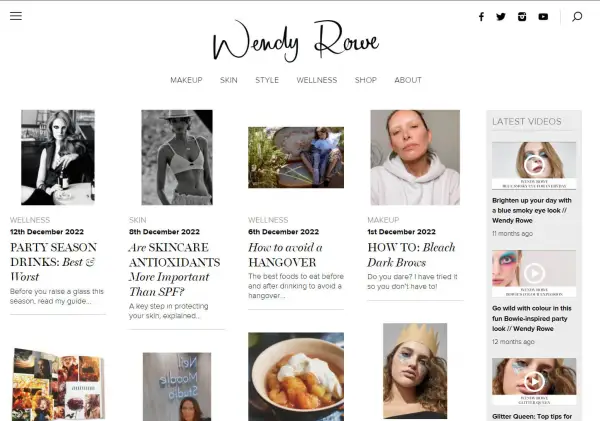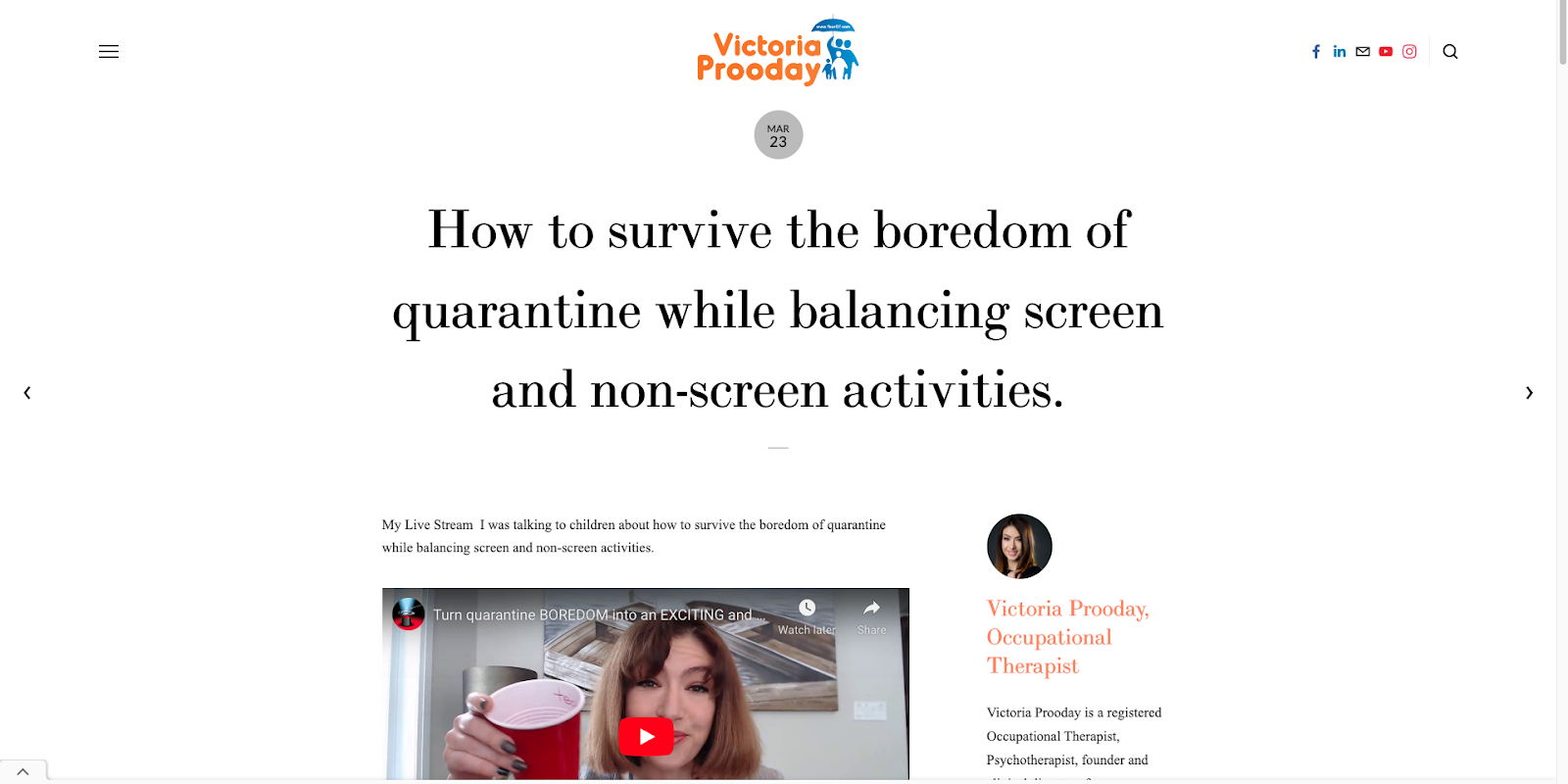
Gone are the days when blogging was just a trendy hobby for people who wanted a forum for self-expression. Nowadays, it seems like just about everyone has a blog — and those blogs cover just about everything. You can find blog examples for any niche, no matter how specialized.
Is it worth learning how to start a blog with all that competition? Yes, particularly for small businesses. Your blog will help generate more business and build a community of loyal customers.
There are many different types of blogs, and your success depends on choosing the right one for your business model and personality. So here are some blogging benefits and tips and an array of solid blogging examples.
What is a blog?
A blog is a website or web page regularly updated with new content called posts. Posts are most often articles but can also include images and videos. When you land on the page, the most recent post displays first.
Bloggers tend to focus on a particular topic or interest, which helps them to develop a brand and regular audience.
The benefits of blogging
I’m not going to lie. Blogs are incredibly effective tools for businesses, but doing them well takes work. Here are a few examples of blogging benefits. Keep them in mind whenever your creative energy flags.
Increase search engine ranking
One of the best reasons to add a blog to your website is the potential to improve your search engine optimization (SEO). When you blog, you show up earlier in search engine results for the keywords that are most likely to bring you business.
Do keyword research to help you plan content and write on topics your target audience wants to read.
When incorporating keywords, consider search intent. What would your reader want from a post on this topic? How would they phrase their query to find just that? Do they want the latest industry news or a guide that will help them address a common problem? Your post should answer their need and try to match their search terms as closely as possible.
In addition to using the right keywords, revisit SEO tips and best practices. You should optimize every piece you post.

Improve conversion rates
Once your target audience arrives at your website, your blog can lead them to make a purchase or sign up for your email list. Blog content that converts often provides customers with useful industry insights or other material that is both helpful and relevant.
Don’t forget to include lead magnets in blog content. Offer readers the chance to download bonus content in exchange for their email address or give them a discount on services they might need.
Conclude your post with a strong call to action (CTA). Tell readers the next step on the journey you’ve imagined for them — the one that turns them from readers into customers.
When outlining your content calendar, include content for people at different places in the sales funnel. Write posts for audiences new to your brand and for ones almost ready to commit.
Build relationships
Blogs also help you deepen your connection with existing clientele. A good blog can improve customer loyalty.
Why? First, your blog should showcase your industry expertise and introduce readers to new products or services. Second, when you share your brand’s story or ongoing projects, you give people a look behind the curtain. That helps them trust and relate to you. They feel more comfortable giving you their business and may even become invested in your success.
Promote brand awareness
Your blog should play a pivotal role in building brand awareness. A good SEO strategy will help you show up in searches, but great blog posts are meant to be shared, extending their reach.
Cross-promote between your blog and social channels to develop communities on multiple channels. Let people know how to stay current with all the amazing projects you tackle.
Boost revenue
You should see more revenue by increasing website traffic and conversions, but successful blogs can also become an additional source. You might sell advertising space on your blog or join an affiliate program for a business or product that complements your offer.

How do you write a blog?
All told, more than 7 million blog posts are published every day. To stand out in a crowded field, you’ll need to approach blogging with the same care you bring to other aspects of your business.
If you already have a website for your business, it should be easy to start a blog. Most website builders include blogging tools, and content management systems like WordPress were designed around blogging functionality.
This means that you can start thinking about the fun part of blogging — writing. Good blog examples should include all of the following:
- A clear focus. What niche, situation, or personality is going to anchor your blog? You need a well-defined theme that unites all of your content.
- A distinct voice and point of view. Why should a reader visit your blog instead of that of a competitor? Ask yourself how you would want one person to describe your blog in a recommendation to a friend. That’s the position you need to adopt in your posts.
- Well-chosen topics. Do your keyword research. Tools such as Google’s Keyword Planner and Google Trends can be valuable sources of insight into what content is likely to pique the interest of your target audience.
- Attention-grabbing headlines. It doesn’t matter how great your blog article is if no one ever reads it. Craft strong headlines designed to stand out in search results.
- Popular blog post formats. Certain types of blog posts perform better than others. Incorporate listicles, how-tos, and head-to-head comparisons where possible.
- Strong organization. Use headings to break up your text at regular intervals. The ideal blog post is easy to scan, so use bullet points, short paragraphs, and other eye-friendly layouts.
- Images/videos. Great visuals accomplish two things. They make your article more appealing and break up the text, making it easier to read. Videos and infographics go even further by presenting information in different formats that many people find more accessible. Play with a variety of media in your blog.
- SEO best practices. Add a meta description to your post. Incorporate keywords at regular intervals. Include internal links between blog posts and external links that acknowledge a reputable, non-competitor source of information.
- Thorough coverage and original insights or information. Find ways to be better than the competition. Introduce new ideas or independent research, or provide longer, more in-depth pieces on topics.
- Accessible writing. Your prose doesn’t need to be poetic — in fact, it probably shouldn’t be. Aim for a readable style that people will understand and enjoy. Avoid highly technical jargon, super-long sentences, and convoluted phrases.
Here are some types of blogs and blog examples that can serve as useful distinctions and models as you refine your approach.
Common types of blogs
There are multiple ways to classify blogs. You can classify them according to topics, industries, formats, or the number of authors. I’ve chosen to look at different types of content. These types each can accommodate several focuses and industries. That means they provide useful distinctions and models no matter what your business is.
Personal
A personal blog focuses on the views and experiences of the author. It can be a public journal that authors maintain to update friends and family about their lives, but it can also be an effective tool for small businesses.
For example, a restauranteur could regularly blog about everything from their favorite farmers’ markets, to amusing anecdotes, to the way they develop new recipes. A personal blog allows the reader to connect with the person behind the business, making them more likely to remember and patronize the restaurant.

Affiliate
Affiliate blogs seek to introduce their audiences to relevant products, earning money from the manufacturers each time users click on links to buy them. They work best when content feels organic and provides value to the consumer. In other words, you need to serve your readers, not just other businesses.
How can this work for you? Let’s say that you own a beauty salon. Why not write a blog reviewing the products you use? You think they’re pretty great. Tell readers why, or provide a tutorial on how to achieve certain looks.
Reach out to smaller manufacturers or look into product lines with established affiliate salon programs. You can demonstrate your expertise to potential customers as you generate affiliate income. Wins all around.
Business
A business blog — sometimes called a corporate blog or a b-blog — is the official online publication of a business. It can be solo-authored, feature multiple writers, or present posts as if they’re authored by the company as a whole. Topics can include the business’s products or services, particularly if there’s something new to report. These bloggers also frequently cover topics related to their industry.
You can find relevant business blog examples by researching top performers in your industry. To pick one, blog post examples for a real estate agency could include articles with titles such as:
- 10 Questions to Ask Your Realtor When Shopping for Your Dream Home
- The XYZ Neighborhood: Why Residents Love This Lesser-Known Gem
- How the Johnsons Turned Their Fixer-Upper Into a Cozy Sanctuary
Including local material would help the agency attract readers in the right area. If your business covers a specific blogger’s service area, try to incorporate location-based keywords as well as industry-based ones.
Niche
Niche blogs focus on given subject matters. For example, “mommy blogs” discuss topics relevant to childcare, and fashion blogs tackle the latest trends and designers.
Niche blogging is an especially strong strategy if your business lends itself to one of the most profitable blogging niches. Topics such as personal finance and fitness generate a lot of web traffic, and related businesses happily pay to be featured on prominent blogs on these subjects.
News
News blogs cover current events for a given area or sector. To start a news blog, you don’t need to be Arianna Huffington (of HuffPost fame). For example, a web security firm could report known breaches and privacy legislation updates.
You could also consider becoming a regular source of community news for your neighborhood or small town. Take the coffee shop bulletin board into the twenty-first century with a café-run blog that covers local happenings. You’ll limit your audience to the demographic most likely to walk into your café for a hot beverage.
Blog examples
Time to see some effective blogs in action. These 10 blog examples cover a range of industries and types. In some cases, blogs have grown popular enough to become a blogger’s primary source of income, but they can still serve as sources of inspiration as you start your blog.
1. Seth’s Blog
Marketing guru Seth Godin started Seth’s Blog more than a decade ago, and it’s become a go-to site for readers who want a taste of Godin’s business sense or calm practicality. He specializes in microblogging, posting short articles (less than 300 words) daily.
Seth’s Blog has become a core part of Godin’s brand as an author and educator. People subscribe because they appreciate his voice and perspective — even as it ranges across topics often only loosely related to marketing. This is one of the best examples of a blog whose success depends more on the writer than on the topics covered.
- Takeaway: Personal blogs often take off because they showcase a personality as much as an area of expertise. Don’t be afraid to experiment with your style as you develop your blog and your readership.

2. Apartment Therapy
In 2001, interior designer Maxwell Ryan started a newsletter for clients, eventually turning it into the successful blog Apartment Therapy. He used it to share design tips directed at helping readers achieve a more organized, joyful, and purposeful living environment.
Today, Apartment Therapy is the number-one independent home site and a media company that manages multiple blogs, newsletters, and marketplaces. In addition to home design, Apartment Therapy now covers lifestyle topics centered on the home, organizing content into clearly defined sections on the site. And if you want more blog examples, you can also check out the sister site: The Kitchn.
- Takeaway: First, think about how you can better serve your current customer base. Why do they come to you, and how can you use your blog to provide the same kind of advice or inspiration? You can grow from there.

3. Wendy Rowe
Makeup artist Wendy Rowe counts celebrities among her clients, but even ordinary folks can achieve the looks she blogs about on her personal site: Wendy Rowe.
Rowe frequently features the latest products and has ample opportunities to earn affiliate income. Her site includes a “Shop My Shelf” section, where users can click on her favorite products. These links take readers to the beauty brand websites that sell the product in question.
- Takeaway: You don’t have to sell products directly to make money from them. If you’re sending business someone’s way, talk to them about becoming an affiliate of their brand.

4. C.R.A.F.T.
C.R.A.F.T. is the center for all sorts of fun DIY projects imagined by Jamie Dorobek. Whether it’s Halloween costumes, DIY nursery ideas, or things to make with post-its, the reader is guaranteed a whimsical good time.
In addition to writing directly sponsored posts, Dorobek always lists (and links to) the materials she uses for a project. She also frequently links to her so-called competition — other crafts blogs — in round-ups of projects for different occasions or media. She’s savvy enough to profit from other examples of blogs in the DIY space.
- Takeaway: While you wouldn’t want to link to a direct competitor, use your blog to cultivate relationships with your peers. Link to their posts or offer to write a guest blog. The mutual promotion will help you both.

5. Brookliving
Brookliving is a blog created by Brooklinen, a small manufacturer of home linens. Brooklinen’s success relies on a clear brand mission: high-quality and responsibly manufactured sheets at reasonable prices.
Its blog never loses sight of the brand but ventures into related lifestyle topics. Irreverence also plays a role in posts such as “Best Sheets to ‘Do It’ In” and “What Research Says About Sleeping With Your Dog.”
- Takeaway: When brainstorming content ideas, think about the tone you want to strike and the material you want to cover.

6. Teach Away
Teach Away, an organization dedicated to connecting people with opportunities to teach English abroad provides an example of a blog for a nonprofit. Its articles are tightly focused on the process and experience of teaching in a foreign country.
Teach Away excels at being useful. It offers potential candidates information on working holiday visas, international teaching qualifications, and profiles of former participants in the program.
- Takeaway: One of the best paths to blog success is creating reader-centric content. What do people need to know about your industry? Odds are that they’re hitting Google to search for just that.

7. Constant Contact
Is it too vain to add Constant Contact’s blog to the list of business blog examples? After all, the fact that you’re reading this article means that we must be doing something right.
Constant Contact’s blog strategy revolves around offering readers useful guides on, and ideas for, digital marketing. The posts are never directly promotional, though they sometimes link to relevant products. This piece is unusual in discussing the company explicitly.
But the people who want to learn more about digital marketing are often those who might benefit from Constant Contact’s digital and email marketing plans. The blog ensures that a steady stream of those individuals finds their way here.
- Takeaway: Branded content achieves many of the same objectives as direct promotions — without the downsides associated with pushy adspeak.

8. Fitness Together
My philosophy on exercise is simple: the workout you will do is always better than the ideal workout you won’t. The niche blog of the local Twin Cities gym Fitness Together seems to adapt this rule to blogging.
Fitness Together only posts once or twice a month, but each piece is a high-quality article that’s around 1,000 words long and relevant to its clientele’s health and fitness concerns. Furthermore, it’s kept at it for years, generating a solid archive that gives the website SEO heft.
Would it be better to post twice weekly and integrate more long-form content? Sure — assuming it also maintained its standards. And you can find blog examples of businesses doing just that. But Fitness Together is too busy running the business. Sometimes “good enough” really is enough.
- Takeaway: Great blogs take time, but that’s why you should start today — not put it off. Do the work you can and will do — now.

9. Victoria’s Blog
There are countless parenting blogs. What makes Victoria Prooday’s blog different? She’s an occupational therapist and clinic director who speaks to parents about the impact of a high-tech lifestyle on early development.
Her blog is part of a strong personal brand, and she’s become a well-known guest speaker contracted by prestigious institutions. Her writing helps her build relationships with the parents of children who attend her clinic for children with behavioral and academic challenges. She gives anxious parents a resource for practical advice and assurance that their kids are in good hands.
- Takeaway: If you’re entering a crowded niche, try to find an angle that differentiates your approach and makes you memorable.

10. Austin Startups
Austin Startups is a strong example o a blog dedicated to extremely specialized news. As the name suggests, it covers startup businesses in Austin, Texas.
Founder Joshua Baer runs Capital Factory, an organization that offers co-working and mentorship opportunities to Texans looking to quit their jobs and found a startup. In addition to regular contributors, guest posters make up a lot of the content on Austin Startups.
- Takeaway: As your blog becomes more established, you can let newer arrivals to the scene guest post, reducing your blogging workload.

Get blogging
These blog examples prove that there are many different roads to blogging success. The best blogs come from a match between writer, topic, and approach.
As you decide which blog type suits you, make a table that lists your options at the top of the page. Then jot down a few content ideas for each. Where do you have the most material?
Remember that some blogs are hybrid. For example, C.R.A.F.T. is a niche blog that generates a portion of its revenue from affiliate programs. While it may take a little time to find your voice and point of view, that’s okay. Do what you can now. You’ll improve with time.




